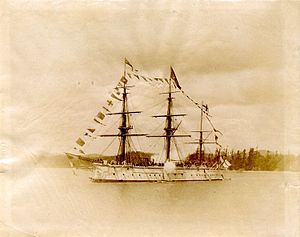Laid down 31 August 1868 Construction started 31 August 1868 Length 85 m | Completed 8 April 1873 Launched 27 September 1870 | |
 | ||
Name Triumph (1873–1903)Tenedos (1903–1910)Indus IV (1910–1914)Algiers (1914–1921) Fate Sold for scrapping, November 1921 Displacement 6,640 long tons (6,750 t) Builder Palmers Shipbuilding and Iron Company | ||
HMS Triumph was a broadside ironclad battleship of the Victorian era, the sister-ship of HMS Swiftsure. These two ships comprise the Swiftsure class of 1870.
The two sister-ships, which were built side by side by Palmers, were designed and built specifically to serve as flagships on distant stations, primarily with the Pacific squadron. They were powered by a Maudslay horizontal twin-cylinder return connecting-rod engine, and were the last British battleships to be fitted with a hoisting screw.
Service history
Triumph was initially commissioned in 1873 for the Channel Fleet, being transferred after a short time to the Mediterranean. She paid off in 1877 to be prepared for transfer to the Pacific as flagship, replacing HMS Shah after her indecisive action against the Peruvian rebel ship Huascar.
On 21 November 1881, while she was off Chile, an explosion occurred in Triumph, caused by a drying compound called "xerotine siccative", also called a patent drier. Three men were killed and seven were wounded. She was relieved by Swiftsure in 1882.
Triumph returned to Portsmouth, where she was refitted, receiving new boilers and launching rails for torpedoes. She served as Pacific flagship from January 1885 until December 1888, and was present at the official opening of the Canadian Pacific Railway in Vancouver harbour in 1887 for both ceremonial reasons and protection against a rumoured Fenian attack. Her relief at that time by Swiftsure signalled the end of her foreign service.
Returning home, she was for a short time in reserve at Devonport, and was then flagship at Queenstown between February 1890 and September 1892. She returned to the reserve at Devonport, where she remained until July 1900. She was disarmed to become a depot ship at Plymouth. Captain Arthur William Edward Prothero was appointed in command on 11 July 1902, for command of Fleet Reserve at Devonport, but the appointment was cancelled and Captain Cecil Thursby was appointed in command from 16 July 1902. In 1903, with her machinery removed, she was a training ship for boy artificers at Chatham under the new name of Tenedos. From 1905 she was tender to Warrior, and in 1910 was moved to Devonport to form part of the stoker training establishment, with the name of Indus IV. She was towed to Invergordon in 1914 to become a floating store with the name of Algiers. She was sold in November 1921, having remained afloat thirteen years longer than her sister.
